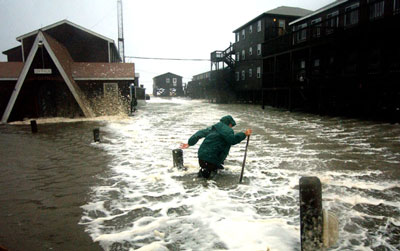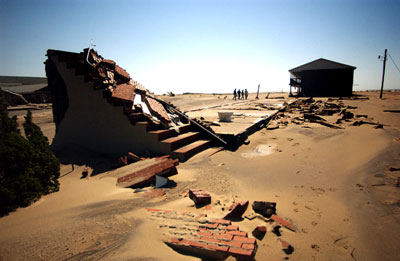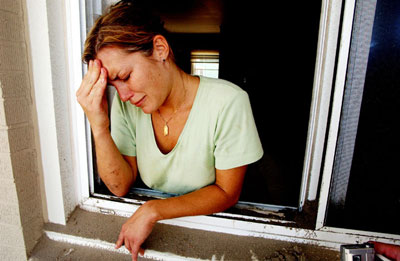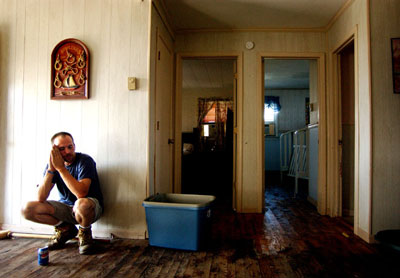It's not quite 7 a.m. on Thursday, Sept. 18, 2003. Wind is howling, the rain pouring down. Hurricane Isabel is expected to make landfall south of us on the Outer Banks of North Carolina in a few hours. Reporter Kyle Tucker and I drive from our hotel in Buxton, North Carolina as far south as we can go in our SUV. We get through the village of Frisco, but Hwy. 12 south of there is flooded. The narrow strip of sand is the only link with Hatteras Village at the south end of the island. We can't get to the village, but we can see white water breaking over the dunes about 150 yards south of us. I shoot some photos of locals trying to get to the village, but they turn and head back north.
 |
Billy Dillon tries to clear a drain in the motel parking lot Steve Earley/The Virginian-Pilot |
Back in Buxton about 9. The wind is building, trickles of water coming over the dunes and running down the streets are turning into whitewater rivers. Debris from oceanfront homes is flowing with the water. A man and his mother drive up in front of a hotel. She owns the hotel. The storm isn't even here yet, and water is already flooding in to the buildings. She and her son try to clear drains to let the water flow away. After a while they give up, look around as the water gets deeper and deeper. The woman walks to the front of the office and stands there for a few moments, watching the water rise as the sea foam blows by. I shoot a few pictures with the wide angle lens, then climb in the SUV and shoot through an open window with a long lens.
At noon the reporter and I are in our motel room, the window is taped and we've stood the couch on end and pushed it against the window. It's too windy to walk outside, the storm winds are throwing debris through the air. We are surprised to find our cell connections still up. So I edit some photos and he writes some notes, we each file back to Norfolk by cell phone as the storm comes ashore. An hour later my wife calls me by cell phone. A Baton Rouge radio station wants me to be in a panel discussion about the hurricane. They had already seen my photographs of the woman at the hotel. I call the radio host and tell him thanks, but I'll be busy for a while. But it is nice to hear that my photographs are across the country already, via the Associated Press.
 |
A brick stairway is all that remains of one section of the Sea Gull Motel Steve Earley/The Virginian-Pilot |
By late afternoon we hear on the weather radio that the eye of the hurricane has moved in to Pamlico Sound, we are now on the back side of the storm. Rain has let up, but the winds are still very strong. I photogaph the damage in Buxton. We cannot get to the south, the road is flooded. We drive north and find half of the road eaten away. I get out to shoot a few pictures. The wind is howling. I sometimes hear a roaring sound, like a fighter jet flying above us. I look up and see nothing. Whirlwinds, or maybe the beginnings of tornadoes in the storm, I'm later told.
The cell phone connections are still up in the evening so I transmit my damage photos. But the cells go down before the reporter can get his story in. He retypes it on my laptop and in the wind and the rain we hook up the satellite phone and send from the balcony. Power is out so we charge batteries on a little Honda generator. Then we sit in the dark and play cards by candle light. Beef jerky and canned peaches for dinner.
 |
Marci Oden recounts being trapped by flood waters in the office of the Sea Gull Motel Steve Earley/The Virginian-Pilot |
Early Friday we drive south through about three feet of water, get in to Frisco and then keep going towards Hatteras Village. The road to the Village is gone. Where we saw water breaking over the dunes the day before is now a new inlet from the ocean to sound. A fresh water pipe, the Village's source of water, juts out of the sands and spews freshwater in to the ocean. With my long lens I can see people standing on the beach across the new inlet. They are stranded, without phone, water or power on what is soon called "Little Hatteras Island." A house that was once part of the Village now sits out in Pamlico Sound. Dolphins swim through the newly formed inlet.
We catch a boat to Hatteras Village. Residents are walking around, stunned by what they see. They gather and compare stories with each other. One elderly woman and her husband spend three hours clinging to a tree. We go to the Sea Gull Motel at north end of a village. Most of the buildings had been picked up by ocean water and moved across the highway. In the one building that hadn't moved we found a woman who had been trapped in the office during the storm. She was there for hours in raging flood waters. Her father had rescued her by paddling a surfboard through the storm. She starts to break down as we talk. After waiting at the docks for a couple of hours we catch a boat back to the main part of Hatteras. We send out the first stories and photos from the Village.
 |
Flood waters from Hurricane Isabel swept through the McCarthy household, destroying much of their property Steve Earley/The Virginian-Pilot |
Two more days until the road off Hatteras Island is cleared. We visit the town of Rodanthe at the north end of the island, hit by storm surge and a tornado. Then back to Little Hatteras Island on Sunday for a church service and the beginnings of the recovery. After two visits to the Village it seems like we know everyone. Monday morning we head back to Norfolk, which has been hit fairly hard as well. Power is out to most residents of Virginia, and trees are downed everywhere. One of the tunnels under the James River connecting the cities of Norfolk and Portsmouth is flooded. The state has been declared a federal disaster area. Hurricane Isabel was ‘only' a Category 1 when it passed through the region. It makes me think of what would have happened if a bigger storm, say a Category 3 or greater, had come through. Considering that Isabel was originally a Category 5 at first I believe we got off lucky this time.






